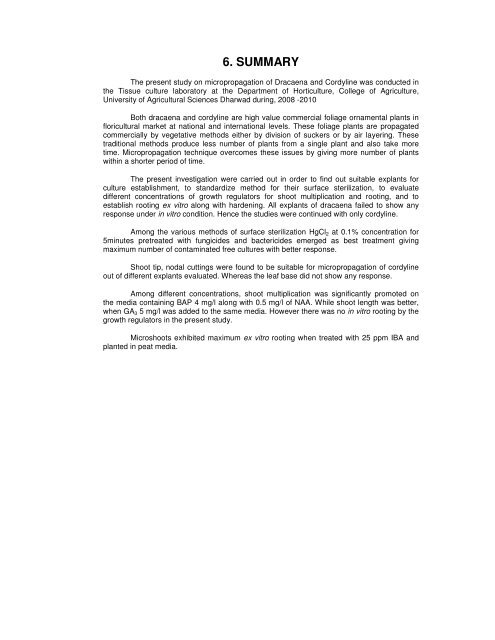micropropagation studies in dracaena and cordyline - ETD ...
micropropagation studies in dracaena and cordyline - ETD ...
micropropagation studies in dracaena and cordyline - ETD ...
You also want an ePaper? Increase the reach of your titles
YUMPU automatically turns print PDFs into web optimized ePapers that Google loves.
6. SUMMARY<br />
The present study on <strong>micropropagation</strong> of Dracaena <strong>and</strong> Cordyl<strong>in</strong>e was conducted <strong>in</strong><br />
the Tissue culture laboratory at the Department of Horticulture, College of Agriculture,<br />
University of Agricultural Sciences Dharwad dur<strong>in</strong>g, 2008 -2010<br />
Both <strong>dracaena</strong> <strong>and</strong> cordyl<strong>in</strong>e are high value commercial foliage ornamental plants <strong>in</strong><br />
floricultural market at national <strong>and</strong> <strong>in</strong>ternational levels. These foliage plants are propagated<br />
commercially by vegetative methods either by division of suckers or by air layer<strong>in</strong>g. These<br />
traditional methods produce less number of plants from a s<strong>in</strong>gle plant <strong>and</strong> also take more<br />
time. Micropropagation technique overcomes these issues by giv<strong>in</strong>g more number of plants<br />
with<strong>in</strong> a shorter period of time.<br />
The present <strong>in</strong>vestigation were carried out <strong>in</strong> order to f<strong>in</strong>d out suitable explants for<br />
culture establishment, to st<strong>and</strong>ardize method for their surface sterilization, to evaluate<br />
different concentrations of growth regulators for shoot multiplication <strong>and</strong> root<strong>in</strong>g, <strong>and</strong> to<br />
establish root<strong>in</strong>g ex vitro along with harden<strong>in</strong>g. All explants of <strong>dracaena</strong> failed to show any<br />
response under <strong>in</strong> vitro condition. Hence the <strong>studies</strong> were cont<strong>in</strong>ued with only cordyl<strong>in</strong>e.<br />
Among the various methods of surface sterilization HgCl2 at 0.1% concentration for<br />
5m<strong>in</strong>utes pretreated with fungicides <strong>and</strong> bactericides emerged as best treatment giv<strong>in</strong>g<br />
maximum number of contam<strong>in</strong>ated free cultures with better response.<br />
Shoot tip, nodal cutt<strong>in</strong>gs were found to be suitable for <strong>micropropagation</strong> of cordyl<strong>in</strong>e<br />
out of different explants evaluated. Whereas the leaf base did not show any response.<br />
Among different concentrations, shoot multiplication was significantly promoted on<br />
the media conta<strong>in</strong><strong>in</strong>g BAP 4 mg/l along with 0.5 mg/l of NAA. While shoot length was better,<br />
when GA3 5 mg/l was added to the same media. However there was no <strong>in</strong> vitro root<strong>in</strong>g by the<br />
growth regulators <strong>in</strong> the present study.<br />
Microshoots exhibited maximum ex vitro root<strong>in</strong>g when treated with 25 ppm IBA <strong>and</strong><br />
planted <strong>in</strong> peat media.

















